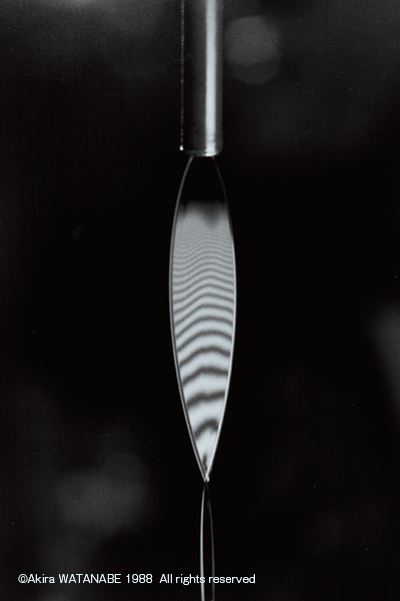
In 1989, Akira Watanabe who was studying femtosecond generation with dye lasers at that time, announced a technique for producing a liquid film with an optically flat surface. * 1
The photo shows the interference fringes that appear on the liquid film (hereinafter referred to as the liquid film) announced at that time. We were able to measure the thickness of the liquid film from the distance between the stripes, capturing the multiple interference between the front and back of the liquid film.
This liquid film contributed greatly to improving the stability of femtosecond light pulses generated from dye lasers at that time. Later, the femtosecond laser evolved in the direction of solidification, and the role of the liquid film seemed to be over.
However, again in 2009, at the Optical Physics Laboratory, Inc., a liquid sample, especially a sample containing a lot of water, was measured by femtosecond terahertz time domain spectroscopy (THz-TDS) using this liquid film. Succeeded. * 2
In 2015, Femto Deployments Co., Ltd. has commercialized THz-TDS by making this liquid film a contamination-free cartridge.
* 1: A. WATANABE, H. SAITO, Y. ISHIDA, M. NAKAMOTO and T. YAJIMA, Optics Comm. 71 (1989) 301.
* 2: Patent application 2009-284993 (P2009-284993)
Akira Watanabe invented a specially designed nozzle in 1989, which generates ultra thin liquid film.As shown in the picture, the generated uniform liquid film exhibits optical interference pattern by which one can measure film thickness accurately.
The liquid-film nozzle originally developed as a key component for stabilization of femtosecond dye laser.However it has not been used for a long time after advent of solid-state laser, Watanabe revived the liquid-film nozzle in 2009, in application of terahertz time-domain spectroscopy (THz-TDS) to liquid sample measurements.
In 2015, FEMTO deployments, Inc. started utilizing this technology in a contamination-free, disposable cartridge system for THz-TDS measurement, for wider commercialization of THz technologies.